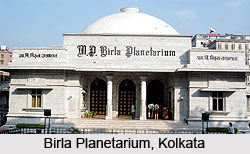 Birla Planetarium in Kolkata, West Bengal, is a single-storied circular structure designed in the typical Indian style, whose architecture is loosely styled on the Buddhist Stupa at Sanchi. Situated at Chowringhee Road adjacent to the Victoria Memorial, St. Paul`s Cathedral, and The Maidan in South Kolkata, it is the largest planetarium in Asia and the second largest planetarium in the world. There are two other Birla Planetariums in India: B.M. Birla Planetarium in Chennai and the Birla Planetarium in Hyderabad. The prominent figure who prompted the need for its inception was M. P. Birla. All the assets and property of the Planetarium had been transferred to the Registered Society of "Birla Institute of Fundamental Research".
Birla Planetarium in Kolkata, West Bengal, is a single-storied circular structure designed in the typical Indian style, whose architecture is loosely styled on the Buddhist Stupa at Sanchi. Situated at Chowringhee Road adjacent to the Victoria Memorial, St. Paul`s Cathedral, and The Maidan in South Kolkata, it is the largest planetarium in Asia and the second largest planetarium in the world. There are two other Birla Planetariums in India: B.M. Birla Planetarium in Chennai and the Birla Planetarium in Hyderabad. The prominent figure who prompted the need for its inception was M. P. Birla. All the assets and property of the Planetarium had been transferred to the Registered Society of "Birla Institute of Fundamental Research".
Popularly known as "Taramandal", the planetarium was inaugurated on 2nd July 1963 by the then Prime Minister of India, Jawaharlal Nehru. The Birla Planetarium has the honour to be the second major Planetarium being set up in the commonwealth countries. It almost was very close with the inception of the planetarium in London just a few years earlier than the Kolkata Planetarium. Though formally inaugurated in 1963, the planetarium started functioning from September 29, 1962. It functioned as an institution that would provide guidance for educational, science and research.
About Birla Planetarium
The second largest of its kind in the world, this planetarium was opened for the spectators on 29th September 1962. Birla planetarium is a spectacular asset of modern Kolkata. It was constructed at a cost of a whopping two million rupees. The area of the planetarium is about an acre, which has given on lease by the West Bengal Government. The planetarium is a single storied, circular structure constructed in pure Indian architectural style. The central dome has a diameter of 27m shaped in imitation of the Buddhist Stupa at Sanchi. Interesting exhibits are the fine collections of paintings, celestial models and busts of famous astronomers that line the corridors. The gigantic planetarium projector accessories comprise of 29,000 parts and combine to portray on the inner ceiling of the planetarium, the naked face of space, Stars, planets and heavenly bodies.
It has an electronics laboratory for design and fabrication of science equipment. It has an astronomy gallery that maintains a huge collection of fine paintings and celestial models of renowned astronomers. The Planetarium also has an astronomical observatory equipped with a Celestron C-14 Telescope with accessories such as ST6 CCD camera and solar filter. It offers to the public and students more than 100 astronomical projects dealing with various facts of astronomy, Astro-physics, Space Science as well as myths concerning stars and planets. It has a capacity of 680 spectators. There is also an Electronics Laboratory for designing and production of scientific equipments. For producing special effects during a show the planetarium has come up with an automatic system for better visual and other special effects. This was possible after a rigorous research of two years, in the year 1993.
Contributions of Birla Planetarium
Birla Planetarium has enhanced the scientific field of the country. The planetarium not only attracts the young but the old as well. It has great contributions in enhancing the scientific and astronomical knowledge of the nation. It has the fame of hosting and participating in more than a few National and International seminars in astronomy and other areas related with it. The Planetarium very frequently also coordinates astronomical excursions which help in the studies of Solar Eclipse and other events of the outer space. The planetarium tries to spread a consciousness among the commoners to increase their interest in astronomy and other things related with it. Journals like "Bust Stories" and "A Brief Introduction of Astronomy" are some of the astronomical publications lately by the Birla planetarium.
Programs in Birla Planetarium
Birla planetarium provides a parlance where astronomical presentations take place. It provides useful piece of information about our solar system, galaxies, life span of stars, space, planets and other heavenly bodies in the most interactive manner via audio video aids. Daily programs are conducted in English, Bengali and Hindi from 12:00 to 19:00 hrs. Programs are occasionally conducted in Oriya, Tamil and Gujarati, as well. Extra shows are arranged on holidays. A free evening course in astronomy is being conducted almost from the very beginning its establishment apart from the courses for children of different age groups. It is a must see place for those interested in astronomy. It enables to explore science outdoors.



















